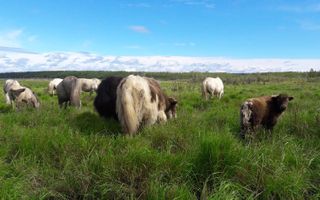Russian Scientists Hope to Restore Ice Age Steppe with 'Pleistocene Park.' Will It Work?

WASHINGTON — Tens of thousands of years ago, the chilly Siberian steppes were vibrant grassland ecosystems, supporting diverse communities of lumbering herbivores such as mammoths, woolly rhinos, moose, horses and bison. But after most of those species disappeared at the end of the Pleistocene epoch (2.6 million to 11,700 years ago) the grassland habitats foundered, with much of the grasses disappearing.
Today, a team of Russian scientists is working to re-create that ancient landscape. In a fenced-off zone in northern Siberia named "Pleistocene Park," researchers seek to restore a vanished world where oversized grass-eaters roamed 20,000 years ago. In doing so, the scientists also hope to address the global problem of climate change, according to research presented on Dec. 12 at the annual meeting of the American Geophysical Union (AGU). [Image Gallery: 25 Amazing Ancient Beasts]
In the Arctic, permafrost cover is currently vulnerable to melt, and melting permafrost releases stored greenhouse gases, said Nikita Zimov, a researcher with the Pacific Institute for Geography at the Russian Academy of Sciences and the director of Pleistocene Park. An estimated 1,400 gigatons of carbon — 1 gigaton is equal to 1 billion tons — is thought to be frozen in Earth's permafrost, according to the National Snow and Ice Data Center (NSIDC).
But reintroducing large herbivores to the Siberian park and bringing back grasslands to the steppes could help protect the permafrost, Zimov said at AGU. Establishing healthy, productive grasslands could also create a more efficient system for storing atmospheric carbon in the soil, he added.
Unlike the fictional Jurassic Park that inspired its name, Pleistocene Park isn't a tourist playground featuring animals brought back from extinction. The park covers 6 square miles (16 square kilometers) and is home to reindeer, moose, musk ox, bison and horses, all of which were brought to the site by Zimov and his colleagues, according to the park's website.
The first animals arrived in 1988, and in the decades since, the ecosystem has adjusted to the presence of big grazers. Changes have already begun to emerge in the park's vegetation, with more grass — which increases in response to being eaten, Zimov told Live Science.
And soil covered by grasses and shrubs retains more carbon than soil topped with forests, Zimov and his colleagues discovered. The scientists sampled soil from within the park and outside its borders, and found higher carbon concentrations in locations where animals had been grazing for the past 20 years. As local vegetation transformed to more grasses, those areas sequestered more carbon from the atmosphere and stored it in the Arctic soil, Zimov explained.
Sign up for the Live Science daily newsletter now
Get the world’s most fascinating discoveries delivered straight to your inbox.
"Where we had the most animals and highest grasses, we had the highest carbon content in soil," he said. Highly grazed areas also demonstrated deeper carbon storage than locations where there was no grazing, he added.

More grass in Siberia could also combat excess methane in the soil, Zimov said at AGU. Since the end of the last ice age, almost 12,000 years ago, Siberian steppes have become wetter, with more methane being produced in the soil as organisms decay. But re-creating ancient grasslands will bring back root systems that leach moisture from the soil, which could reduce methane production, Zimov said. (In wetter soils, where oxygen becomes depleted, the microbes that break down carbon produce methane rather than carbon dioxide.)
Meanwhile, increased snowfall during the past three winters has further jeopardized the permafrost, by creating an insulating layer that warms the earth underneath and prevents it from freezing, according to Zimov. In many locations, researchers found that layers of ground remained unfrozen year-round — a warning that the permafrost could be starting to degrade.
"And once it starts, it's a rapid process and it's very hard to stop," he said.
Though Siberia's mammoths and woolly rhinos are long gone, other large herbivores alive today could safeguard the permafrost by doing what their predecessors did when they roamed the tundra — trampling down the top layers of snow, Zimov said.
"This will allow soil underneath to cool and will prolong the life of permafrost in the Arctic — which will buy us some time," he said.
- Photos: Ice Age Mammoth Unearthed in Idaho
- 10 Extinct Giants That Once Roamed North America
- Mammoth Resurrection: 11 Hurdles to Bringing Back an Ice Age Beast
Original article on Live Science.

Mindy Weisberger is an editor at Scholastic and a former Live Science channel editor and senior writer. She has reported on general science, covering climate change, paleontology, biology, and space. Mindy studied film at Columbia University; prior to Live Science she produced, wrote and directed media for the American Museum of Natural History in New York City. Her videos about dinosaurs, astrophysics, biodiversity and evolution appear in museums and science centers worldwide, earning awards such as the CINE Golden Eagle and the Communicator Award of Excellence. Her writing has also appeared in Scientific American, The Washington Post and How It Works Magazine.
